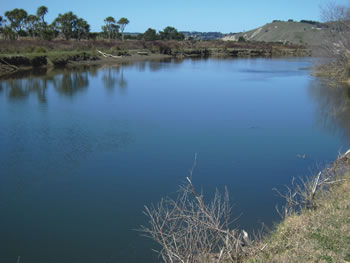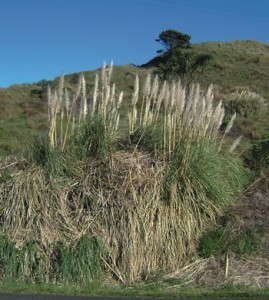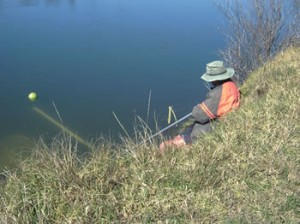Reflections on Silence in the Whitebait Season
 When the toetoe talks it is time to go whitebaiting. The beginning of the whitebait season is eagerly awaited in this family with members far and wide hoping to be on the receiving end of good catches. I am not a fishing woman. The closest I came to whitebaiting was to knock over the bucket that housed the catch. That was in our romantic courting days. Today I stay in bed when the fisherman gets up early to catch the tide. But I like to keep an eye on things and this is how I discovered on a long, not so early, morning walk to check on the fisherman, that toetoe talks.
When the toetoe talks it is time to go whitebaiting. The beginning of the whitebait season is eagerly awaited in this family with members far and wide hoping to be on the receiving end of good catches. I am not a fishing woman. The closest I came to whitebaiting was to knock over the bucket that housed the catch. That was in our romantic courting days. Today I stay in bed when the fisherman gets up early to catch the tide. But I like to keep an eye on things and this is how I discovered on a long, not so early, morning walk to check on the fisherman, that toetoe talks.
Of course to hear toetoe talking one needs a window of silence, some early morning sun and a stillness of air. In April toe toe, (Cortaderia), thrusts its plumage skywards in the creamy green, russety shades of Autumn. These are a seasonal sight to behold, akin to the pleasure of seeing the first bulbs of spring. I am not aware that the first green shoots of flowering bulbs make music when they burst through the earth. The whole experience of waiting for the first signs of a new season is largely a joyful, visual experience that does not admit of mechanical detail, so to speak.
However there are hidden workings that go on in nature during the good season of spring which have glorious consequences in another season. It is in spring, when nature stirs herself from inertia, that the new Cortaderia shoots, which will become the crowning glory of autumn, announce their beginning to the world. To look at toetoe in spring is to see a plant ravaged by winter winds and sea spray. It is not a pretty sight. The remaining plumage is thin and frayed, and the heart of the bush tatty. But it is the tatty stuff that talks when warmed by early morning sun. Hearing it is not rocket science. If one simply appreciates silence, is weathered enough by life to look for beauty in messiness, then one can hear toetoe talking.
We need silence in our lives like we need solitude. Most people I know will seek and enjoy solitude for short periods but often want to fill that solitude with noise of their choice. We tend to think of silence as what happens when the noise we make as human beings stops. The best experience I have had of this kind of silence was the morning after the 9/11 attacks on the Trade Centre in New York. I had been to Mass and afterwards I went to the Warehouse. A voice over the intercom asked for a one-minute silence for the victims of that disaster. I could have heard a pin drop. There were children in the store, but not a sound was heard for that minute. It was a pressing, powerful silence with a presence not of this world.
The silence a crowd can create in a silent minute is powerful because we do not expect that many people to be quiet for that length of time. It seems that making noise is a natural part of being human. Nature herself offers us silence but it is the sort of silence we must listen out for. It does not press in on us like manmade silence. Rather it opens out around us inviting us to hear it.
A little bit of silence goes a long way. Living with extended silence is not easy. As Catholics we know that we should seek some silence in our lives in order that we might know ourselves a little better and make a space, so to speak, for God to speak to us. Mostly we think of this silence as associated with prayer, both personal and public, but perhaps we would be happier if we had a general appreciation of silence, not just as something we create, but as a presence that God gives to us through his creation.
Silence comes into our lives when ‘less is more’. When we simplify our lives with less people, less busyness, less music, television, talk, meetings etc., we enable our hearts to be more open to the presence of God in silence. God speaks to my heart in the softest of voices. In fact spiritual writers say that God speaks to me silently. This sounds a bit like double-Dutch. How can I hear a silent voice?
There are men and women who have left the noise of the world for the enclosed, silent life. Their lives encourage those of us who must remain amongst the clamour to seek some silence in life. Sometimes we visit them in order that their silence may rub off on us. However the best plans for our retreat into silence can go awry. Life must go on even in the enclosed life. There is always work to be done, but why does that plane have to top-dress, or the extensive lawns be mowed on the two days that I seek some silence in a rural idyll?
Seeking silence is good. Wanting it on tap when I am ready to enter it is perhaps not so good. Like many aspects in our faith lives, it is best if we do background work in our everyday lives rather than separate what we may deem ‘spiritual’ into a position over and above the ordinary. Prayer is probably the best example of the way we separate out the spiritual, talking about a ‘prayer life’ as if it is something different from the rest of our life. Since the Second Vatican Council called us all to holiness we are getting better at appreciating the way our everyday lives must be holy. And so building up an appreciation of silence by bringing it into our homes and workplaces is part of Catholic lay life.
The toetoe talking is actually part of silence. That is nature’s gift. Those who live with silence tell us that silence has a noise all of its own. The thoughts and anxieties that fill our hearts and minds when man-made noise ceases are often difficult to endure. Silence pushes us up against ourselves so to speak. It floods our being with things we would rather forget, perhaps our own sinfulness, perhaps our fear of death, perhaps the unfairness of others towards us and thoughts of striking back. All of these sorts of thoughts clamour for attention when we remain in silence before God.
The tatty stuff of everyday life is what we talk to God about in silence. In little voices that others cannot hear we tell God about our worries and anxieties. What does it sound like and look like? Well I think it is music to God’s ear sounding like the soft crackling of the toetoe talking and perhaps looks like the solitary fisherman catching ‘baits’ for the table.
- Whitebait is a freshwater fish delicacy available in NZ rivers in early spring. The fish are the juveniles of the inanga river smelt. Delicious to eat prepared with a light batter fried in butter served with lemons.
- Sue Jones is a writer from Mahia, NZ. She is married to Tim who is a whitebaiter and photographer. They are grandparents and like the outdoors.



 Entries(RSS)
Entries(RSS)